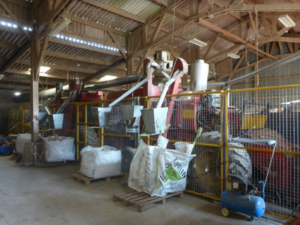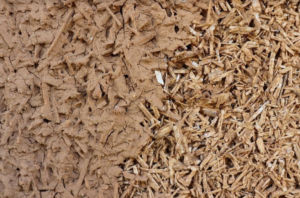Eco-Pertica
Eco-design

![]() France
France
Web: www.ecopertica.com
Contact: contact@ecopertica.com
Location: Normandy region of the Perche, France
Sector: Agriculture and Construction
Date of creation: 2010
Date of analysis: May 2020
Project maturity: mature and viable
A cooperative developing a local hemp industry in the region of Perche in France.
overview
Eco-Pertica is a cooperative society of collective interest (SCIC) resulting from the merger of 2 associations: the association Chaux, Chanvre et Compagnie which put in network self-constructors and craftsmen to share their experiences on eco-construction and the association L’apport de l’éco-vivre which aimed to raise awareness of eco-living in general (housing, travel, leisure, food …).
Eco-Pertica is the result of Antoine Elleaume’s desire, as manager of the cooperative, to develop the local resources of the Perche and to raise awareness of eco-construction among the inhabitants and actors of the region.
Hemp was cultivated in the Perche region during the first half of the 20th century and was used for weaving and cordage for sea-going sailing ships as well as for the paper industry. [2] Thus, the cooperative wished to recreate and revitalize a local know-how to use it this time in construction, by returning to traditional methods.
France is the largest hemp producer in Europe (more than half of the production area) [1].
The cooperative includes
- 6 farmer-members
- 25 ha of crops
- 1 machine for processing hemp into building material (thermal insulation)
- 2 co-products of marketed hemp
Number of construction sites per year (2019 figures)
building sites supplied in hemp, wool or goatskin : 60- sites carried out in soil-hemp projection: 6
- Renovation projects accompanied from conception to completion: about thirty.
- TURNOVER : 150 000 €.
Scope of influence
- Eco-construction support: 50 km around the head office
- Sale of eco-materials : 100 km around the headquarters
- Eco-Design
As a reminder, eco-design is the act of “designing an offer of products (goods or services) more respectful of the environment.” [3]
Eco-Pertica aims at minimizing the environmental impact of hemp at every stage of its life cycle.
The supplying of hemp for eco-construction is done in the most sustainable way possible. The hemp is not labelled organic but no phytosanitary products are used and there is no watering during cultivation.
The transformation of the hemp into building material is done with a machine developed by the cooperative and is located on the farm of one of the farmer-members.
The desire to develop a local micro-sector limits transport. Thus between the raw resource and the final product, less than 100 km are travelled.
This is a very good example of a short circuit, where the consumer (the craftsman or self-builder) is in direct contact with the producer.


project operation
The life cycle of hemp is as follows:
Following its cultivation between May and September, the hemp is harvested and defibered using a machine set up by the farmers of the cooperative. The hemp can then be used in several forms in eco-construction sites: in an soil-hemp mixture as plaster, as insulation alone in the form of fibre or bundles of wool.

Cultivation of hemp

Defibration line

Hemp wool boots

Hemp coating

Soil-hemp plaster
Micro sector: A sector includes all the activities from upstream to downstream to the realization of a product. A micro-sector includes all of its activities in a very localized perimeter. Eco-Pertica produces, transforms and markets hemp in the Normandy region of Perche, which is located in the departments of Eure, Eure-et-Loir, Orne, Sarthe and Loir-et-Cher. The majority of construction and renovation projects are those of traditional buildings in the Perche region.
Biosourced material: This refers to a product made from biological material (plant, animal, algae) such as wood, straw or sheep’s wool. [4] Hemp used as thermal insulation is therefore a bio-based material and can be used alone or with other materials.
Eco-construction: Eco-construction is the act of creating, restoring or renovating a building in a sustainable way by respecting the environment. This is mainly done through the use of renewable materials that are low in energy consumption and pollution.
Eco-Pertica is a cooperative that wants to promote eco-living, craftsmanship and local development of the hemp sector.
Its two income-generating activities are the sale of hemp and eco-construction consulting. Thanks to its expertise and experience, Eco-Pertica accompanies self-constructors or craftsmen in the renovation of buildings in the Perche region in order to optimize energy performance while respecting the environment and traditions. For example, the cement used as plaster on the walls is replaced by soil-hemp plaster, which allows the walls to breathe better and is more eco-friendly.
Eco-Pertica is also very committed and organizes various non-remunerative activities to promote eco-living and the hemp industry.
First of all, the cooperative works continuously to develop new techniques and new tools to work hemp. Their objective is to find ways to use hemp with the least possible processing.
The cooperative is also implementing awareness and communication actions. For example, it organizes eco-building cafés where people can present their construction or renovation projects and exchange with others. This helps to create a real culture of eco-construction in the region. The employees also organise voluntary information evenings on a variety of themes related to eco-living.
Finally, Eco-Pertica participates in research programs to better understand the technical characteristics of materials as well as in research shared with other local French hemp industries in order to study the common points and variability of the properties of different hemp.
Historically, hemp in France was used in the textile and paper industry. Other outlets have developed over the last few decades, such as thermal insulation in construction, bio-sourced plastic, the automotive industry and animal bedding.
It is an annual plant (sowing in May and harvesting in September), easy to produce and has many agronomic advantages. For example, it increases the yield of the next crop by 5 to 10% and breaks disease and weed cycles. It is a plant conducive to biodiversity because of the height and density of crops, in which some animals can hide. Its cultivation requires no phytosanitary products and little irrigation since hemp is drought resistant thanks to a deep root system. [4]
Hemp can be used in many different ways. Within Eco-Pertica, 2 co-products are mainly manufactured for eco-construction:
Hemp wool: hemp is the longest plant fibre that exists and the bark (phloem) of the plant can be used as roof insulation after defibration.
The hemp pith: The pith of the plant (the xylem) can be crushed into flakes and mixed with clay soil to be used as insulating plaster on walls.
During the hemp defibration stage, 15% of the defibrated material is reduced to dust. This hemp dust is also valuable as it is an excellent absorbent for dry toilets and can also be used as mulch or anti-slug.
Some farmers of the cooperative also valorize the seed for human consumption in several forms such as oil, flour and hulled seeds.
Flowers could also be used for medicinal purposes but this is hindered by French regulations on CBD, a molecule with relaxing properties.
The use of hemp as insulation avoids the use of non-biosourced insulation such as glass wool, rock wool and polystyrene. On the other hand, hemp wool performs just as well as other insulations and, for the same density, is more economical.
Unlike other materials, hemp has a positive impact on the environment since it is a carbon storage well. Indeed, 1 hectare of hemp absorbs as much CO2 as 1 hectare of forest, i.e. 15 tons. [4]
Eco-Pertica uses a coating made of hemp and clay soil recovered from construction sites or from local farmers. This allows the valorization of waste, limits the extraction of mineral raw materials such as lime and saves energy since it is a local material. Indeed, unlike lime, the soil emits less CO2 since its transport is located in the Perche region and does not need to be fired before being used as a plaster. The earth-hemp combination is therefore a sustainable coating which is a real carbon sink.

Insulating a house with hemp
sustainable approach
From its production to its use as thermal insulation hemp has many environmental advantages. (see parts III and IV of the presentation of the circular economy approach).
The creation of a local micro-sector allows a considerable reduction of CO2 emissions linked to transport, since a maximum of 100 km are travelled between a hemp farm and a construction or renovation site.
For builders or renovators, for the same density, hemp wool is more economical than these non-bio-based alternatives.
On the other hand, thanks to its legal form and the development of the short circuit, Eco-Pertica ensures a good remuneration for the producers, who themselves transform hemp into wool or hemp pith and sell it directly on their farms.
Thanks to its commitment to promote hemp and eco-living in the Perche, Eco-Pertica has a real impact on the habits of the region’s craftsmen and self-builders. By creating a network of craftsmen who are experts in eco-construction, the cooperative supports local crafts and traditional trades and wishes to put crafts back at the heart of construction activity.
replicability and future perspectives
Eco-Pertica is federating at the national level to promote the local hemp sectors to the ministries.The cooperative is part of the association “Chanvriers en Circuits Courts”. Created in 2009, this association brings together groups of farmers who cultivate within local micro-sectors of hemp production for eco-construction in France. [5] The member groups of the association meet twice a year to discuss various issues related to the development of their local sectors (notably the processing and distribution of hemp). This willingness to be autonomous and not to create a large cooperative allows to encourage new actors in other regions to start developing a sustainable and viable local hemp micro-sector.
The cooperative has been around for 10 years now. As its economic model is not yet stable, it is seeking to develop new ways to perpetuate it.
Its objective is still to keep a local and artisanal activity (only a few projects have been carried out outside the Perche region near Caen and in Brittany, 200-250 km from the head office).
The very strict regulations, certifications, labels and standards in the construction industry are a brake on the development of local sectors. However, this in no way prevents the trust that naturally exists between the producers and the end customer since the chain has no intermediaries.
A long-term project would be to set up a hemp training centre to develop the skills of actors in the sector and attract new ones.
